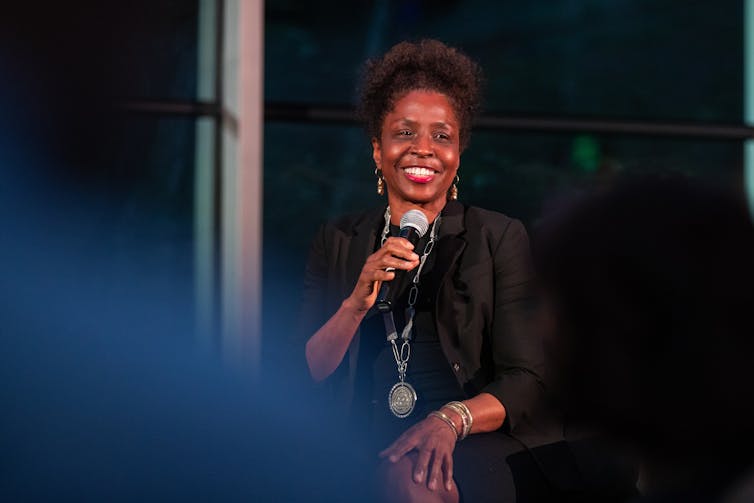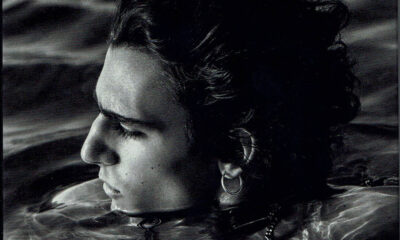Art
Making Art ‘Should be Uncomfortable’ – a Conversation With Visual Artist Lorna Simpson
Simpson’s work focuses on experimenting and discovering new ways to develop imagery.

Paul Rutherford/Tufts University, CC BY
Christina Sharpe, Tufts University
Lorna Simpson, a pioneering visual and conceptual artist whose striking work on race, gender and identity has placed her among the leading artists of her generation, was recently honored by the School of the Museum of Fine Arts (SMFA) at Tufts University with the SMFA Medal, given annually in recognition of creative excellence in visual art, art history and arts advocacy. Simpson’s works have been presented in many of the world’s major art museums. Much of Simpson’s work focuses on experimenting and discovering new ways to develop imagery.
Below is an excerpt from a public conversation, edited for clarity, between Simpson and York University Professor Christina Sharpe, Ph.D., at the Museum of Fine Arts, Boston, where the SMFA at Tufts honored Simpson. Sharpe, a professor of English at Tufts when she spoke with Simpson, is a renowned feminist critic and author of “Monstrous Intimacies: Making Post-Slavery Subjects” and “In the Wake: On Blackness and Being.” Her scholarship is dedicated to the same concepts explored and confronted by Simpson’s work.
Christina Sharpe: I was introduced to your work when I was in graduate school at Cornell through an image of “The Waterbearer” that appeared on a syllabus. The text [on the image] reads, “She saw him disappear by the river, they asked her to tell what happened only to discount her memory.” I wonder if you could talk some about that early work in conceptual photography, the combination of image and text?
Lorna Simpson: That work was from 1985 or ‘86. By the time I got out of college, I was really questioning what I was doing with photography. I had opportunities to show; I had looked at a lot of work, and the way that work was being presented by photographers, but I kind of felt there was some assumption that was being made about how these images were being read. That got me to think about a different way of viewing an image with meaning.
“The Waterbearer” actually comes from a memory of my father’s relatives – my father was from Cuba and Jamaica – and how they would talk about their days between Jamaica and Cuba, and just different family events that there was a lot of secrecy around. In those stories, and in the conveyance of memories, I noticed there was a lot stopping short, or a tendency not to fill in all the blanks. There also was the consideration that memory is a contentious situation in a way, so that what one wants to voice in terms of memory doesn’t always get acknowledged. I think “The Waterbearer” was a contemplation about that.
Christina Sharpe: I wonder if you could tell us a little bit about some of the other conceptual photographers who influenced you. Who were you in conversation with? Who inspired your work? Who did you want to interrupt or contest?
Lorna Simpson: In the late 1970s, the canon of art history and photography was quite narrow, and so I spent a lot of time being on the Lower East Side, and also up in Harlem. What was interesting about that, and also being an intern at the Studio Museum in Harlem, [was that] I had this view of a whole other arena of practice. I immediately saw that there was this gulf between what I was learning and what I was seeing in the world, and that what was presented to me educationally was quite narrow.
I found myself in all these amazing situations that opened my eyes to the practice of contemporary art. I would say David Hammons was really important to my work. There was also Charles Abramson, and then maybe later Adrian Piper.
Christina Sharpe: Your most recent body of work marks a change from that practice; obviously, your practice has evolved. I wonder if you could discuss the work that uses, for example, those vintage images from [the magazines] Jet and Ebony, as well as found images, and if you could speak to your movement to painting and sculpture?
Lorna Simpson: It was interesting going to [the University of California San Diego] in the early 1980s, because it was an era of performance art, and I found myself to be in this pool of people who were interested [in performance art]… Although it wasn’t an art form that I was particularly comfortable with, personally, the “performative” aspect of my work came from being immersed in that community.
I would say from that point on I didn’t feel wedded to a particular way of working, or that I had to have a particular medium in working a particular way that would define my entire career. It was more [that] the structural or conceptual idea framed how the work would be made. When working and painting now, […] I kind of feel like I don’t fear failure. I don’t have the sense that I need to do something more comfortable, because I think in terms of making art, and writing, and anything that we do as artists where we have to step up to the plate, it should be uncomfortable, it should be nerve-wracking, and there should be this level of unknown. Not at all times, but at certain points.
Christina Sharpe: There’s a book by Tina Campt called “Listening to Images.” She invites us to listen to these mundane, compelled photos, in which we might hear something like “black refusal,” or “desire,” which is to say that one may locate in them the dynamics of black life. I want to ask you, what do we hear in your work?
Lorna Simpson: I think my work is a conversation between me and me. I look in the mirror, I get up every morning, and I don’t go, “Oh my god, there’s a black woman in the mirror in front of me!” I take for granted and strongly have a sense of ownership of my own experience. And in the ownership of that experience, I have the expectation that my audience has to come with me, and that there is a universalism that I assume in what I’m doing. So while the work pictures black bodies – and considering the particular climate in which we’re living now, and the way that American politics have, in my opinion, reverted back to a caste that none of us want to return to – that that specter of the work is important. But at the same time, as a country – and speaking as an American – there has to be this kind of universal acknowledgment that America means many different things to many different peoples from many different places. And particularly, if you are not Native American and your people haven’t been here for centuries before the [17th century] settlement of America, then those experiences have to be regarded as valuable, and we have to acknowledge each other. This is the premise by which I view the world.
Christina Sharpe: Many years ago, in an interview that I read in BOMB magazine with Coco Fusco, you said, “I do not feel as though issues of identity are exhaustible. The notion of identity, be it self-constructed, or as an imposed ideology from outside, means to me that it’s a complex and contradictory system.” You said also that complexity’s what’s most interesting, and so I wonder if you could speak more about that complexity and questions and practices of image-making?
![]() Lorna Simpson: Now I have a daughter who is 19, and watching her come of age, and seeing other young women in her circle and how they think about gender and sexuality, I am so grateful and overwhelmed that they actually read work that was written in the 1960s and 1970s and 1980s. But their conception of how we think now about gender and binary systems doesn’t even consider those [older] ideas [from the 1960s, 1970s and 1980s]…they’re like, “Oh, please, we’re not even going to talk about that.” I find that to be really amazing, and I am heartened by that. I feel that the younger generation of people understands the heart of gender and sexuality concepts, and understands where it leads. I find that exciting and amazing, and I’m grateful that that’s the case.
Lorna Simpson: Now I have a daughter who is 19, and watching her come of age, and seeing other young women in her circle and how they think about gender and sexuality, I am so grateful and overwhelmed that they actually read work that was written in the 1960s and 1970s and 1980s. But their conception of how we think now about gender and binary systems doesn’t even consider those [older] ideas [from the 1960s, 1970s and 1980s]…they’re like, “Oh, please, we’re not even going to talk about that.” I find that to be really amazing, and I am heartened by that. I feel that the younger generation of people understands the heart of gender and sexuality concepts, and understands where it leads. I find that exciting and amazing, and I’m grateful that that’s the case.
Christina Sharpe, Professor of English, Tufts University
This article was originally published on The Conversation. Read the original article.
Jumpstart a career doing something you are passionate about with one of College Media Network’s courses. Read about our current offerings, schedule and unique virtual learning environment here.











